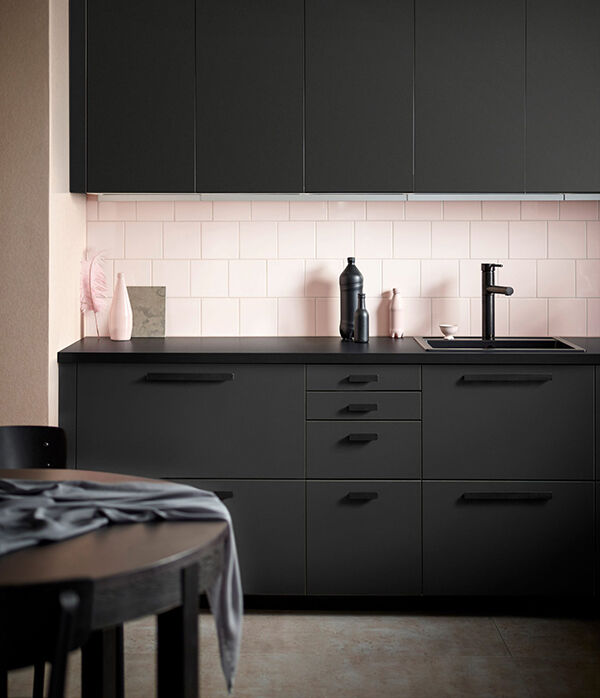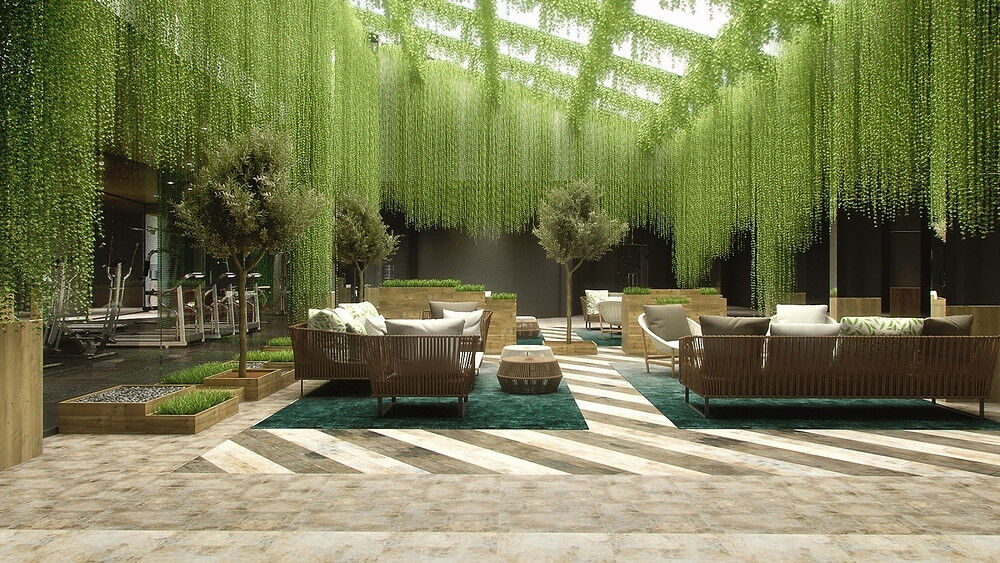Photo courtesy of Mahla Office Furniture

We’re highlighting three sustainable interior design trends that experts are forecasting to dominate in 2023. If creating an ecologically friendly space sounds intimidating, don’t worry—these simple and easy tips are sure to be attainable by everyone.
Photo courtesy of Ikea

Biophilic design brings the outdoors inside: natural materials, textures, and colors are incorporated into the elements of a living space. This may simply involve selecting materials like wood and stone instead of plastic or metal. For those seeking a stronger connection to nature, interior designers recommend integration of fauna or water-features. Apart from the traditional succulent, freshly cut branches, flowers, and moss can easily be arranged on tables or walls. Installing a small fountain on a countertop provides the tranquil sound of trickling water throughout the day.
Another hallmark of biophilic design is enhanced natural light, which can be achieved by placing reflective surfaces, like mirrors, opposite windows, or glass. Utilizing natural materials improves indoor air quality, simultaneously reducing the chemical pollution coming from synthetic manufacturing. With natural light as a space’s primary light source, electricity use (and cost) is cut significantly. Published health benefits of biophilic design include elevated productivity, increased mental-health, and decreased stress levels.

A circular-economy system is gaining fast popularity within sustainable interior design. Upcycling and repurposing, two core concepts within this area, represent related but slightly distinct practices. While upcycling transforms old, discarded materials into new products, repurposing finds alternative uses for existing items.
You’re probably familiar with a few companies that already utilize a common upcycling method—junked plastics are broken down and converted into unlikely merchandise. For example, IKEA has debuted a whole line of accessories made from upcycled plastics, including items like medicine cabinets, soap dispensers, and pillow coverings.
If shopping for upcycled products isn’t your speed, repurposing is an easy, fun approach to DIY projects. Sauce jars can effortlessly double as flower vases, or tin cans as pencil holders. More elaborate ideas involve arranging old silverware into windchimes, or fitting pin rollers into wood-board cut outs, creating farmhouse style coatracks.
Upcycling and repurposing limit the volume of material making its way to landfills, reducing methane emissions and groundwater pollution. Both also introduce a sense of creativity and whimsy, adding joy to interior spaces.
Photo courtesy of diyncrafts.com

Whether in furniture, accessories, or in the architecture of a space itself, selecting eco-friendly materials is a fundamental pillar of sustainable interior design. You’ll find an array of options on the market, ranging from cork and recycled aluminum to kelp and mycelium. Bamboo is an emblematic case study, demonstrating sustainable design’s benefits for both environment and consumer. It regenerates from its roots and farmers do not need harmful pesticides or complex fertilizers in its cultivation. The regrowth process is also extraordinarily efficient, with each plant reaching full height within a single season. For end-users, bamboo represents one of the strongest building materials available (boasting a tensile strength about 6 times greater than steel) and is resistant to the shrinking and swelling commonly seen with temperature change. Bamboo is a sustainable resource that not only minimizes environmental impact, but lasts longer, saving money, time, and effort on repairs and replacement. Design firms seem to have caught on—there is now a host of applications to choose from; just a few to look out for in your next project include bamboo window screens, flooring, countertops, or sturdy furniture pieces like desks and cabinetry.
Photo courtesy of Choices Flooring

Ultrafabrics consistently strives to find new, innovative ways to bring about a greener future. Offering sustainability without sacrifice, we are proud to have reached milestones like Indoor Advantage Gold Certification, REACH Compliance, and inclusion in the Mindful Materials Library. Ultrafabrics’ portfolio is 90% PFA free, and by 2025 our entire portfolio* will contain at least 50% renewable and/or recycled ingredients. If you’re in the sustainable spirit, we invite you to peruse our Volar Bio collection. Combining corn and wood-pulp based materials, Volar Bio touts a 29% USDA BioPreferred Program label.
* Ultrafabrics brand products sold to furniture, healthcare,
recreational vehicle, marine, aviation, and accessories markets
Photo via Pinterest








